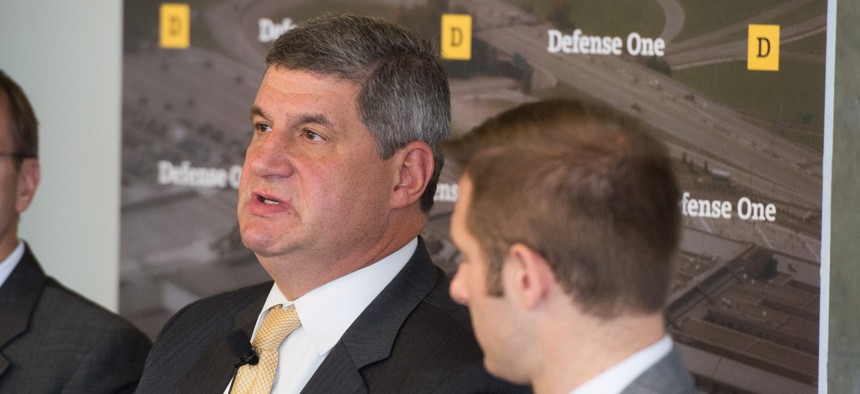
Bill LaPlante, President Biden's nominee to become the Pentagon’s top weapons buyer, speaks during an October 2015 Defense One event. At the time, LaPlante was the Air Force’s top weapons buyer. Defense One photo
Former Air Force Weapons Chief Tapped as Pentagon’s Lead Arms Buyer
Bill LaPlante has spent the past six years working on military-related tech.
Bill LaPlante, who left the Pentagon in 2015, has spent the past six years working on technologies the military craves. President Biden said Tuesday that he would nominate the former Air Force weapons chief to become the Pentagon’s top arms buyer. Politico first reported his nomination.
Autonomy, machine learning, and other software, to name a few such areas, have been front and center in LaPlante’s post-Pentagon roles overseeing key technology at Mitre and Draper Labs, two non-profit research-and-development organizations that support the Defense Department.
If confirmed by the Senate, LaPlante would get the chance to institutionalize many of those efforts inside the Pentagon. But he also faces a number of immediate challenges, including a supply-chain crisis that has increased costs and delayed weapons projects.
“LaPlante is well known to the Senate Armed Services Committee and should have no trouble with the confirmation process,” Arnold Punaro, chairman of the National Defense Industrial Association, said in an emailed statement.
Still, 22 other Biden picks for Pentagon jobs are currently hung up in the Senate, Capital Alpha Partners’ Byron Callan, wrote in a note to investors. The White House has yet to identify nominees for 13 other Pentagon positions. And many of the acquisition billets within the office LaPlante would oversee are filled with acting officials.
If confirmed, LaPlante would join two of his former Obama administration acquisition colleagues, current Air Force Secretary Frank Kendall and Heidi Shyu, the undersecretary for research and engineering.
Callan, the Capital Alpha Partners analyst, said “addressing DoD software acquisition culture/practices” will be among LaPlante’s top biggest tasks. Other priorities should include “making better use of the acquisition tools Congress has provided DoD to accelerate program development and procurement, and to encourage new entrants, and...improving DoD sustainment practices and policies,” Callan wrote.
LaPlante would also be expected to help shape the Pentagon’s position on defense industry consolidation and to determine the fate of a popular pandemic policy of paying contractors more money up front to create more liquidity within the supply chain, Callan wrote.
“He has a great background and understanding of the industry, which also has a high and deep respect for him,” said Hawk Carlisle, president and CEO of the National Defense Industrial Association. LaPlante serves on NDIA’s board.
In an October 2020 LaPlante credited a handful of acquisition policy changes—including “rapid middle-tier prototyping and acquisition pathways; rapid capability offices in the Army, Air Force, and Space Force; expanded other transaction authority; rapid experiments; and pitch days where small businesses propose ideas and DOD cuts a check on the spot” — with speeding innovation.
“These are needed tools that provide buyers flexibility and alternative approaches, while freeing innovators from one-size-fits-all application of DoD’s sometimes-byzantine processes,” LaPlante wrote in a Defense One commentary co-authored with Jamie Morin, an executive at the non-profit Aerospace Corporation and former Obama administration Pentagon official.
During his time as the Air Force’s top weapons buyer, LaPlante oversaw a team that chose Northrop Grumman to build a new stealth bomber, something the military had not done in more than three decades.
After leaving the Pentagon in late 2015, LaPlante went to work for the MITRE Corp., where he oversaw more than 4,000 scientists and engineers supporting the Defense Department. There, LaPlante focused on making the non-profit’s federally funded research and development centers respond faster to Pentagon and intelligence community emerging needs. He oversaw efforts involving the new nuclear command-and-control systems, automation, artificial intelligence, cyber security, protecting satellites in space, and making the security clearance process faster.
LaPlante is also on the board of Lift, a Detroit-based, public-private partnership between the Defense Department, industry, and academia, working on the development and deployment of advanced manufacturing technologies. He was also a member of the Defense Science Board, where he co-chaired the Task Force on Gaming, Exercising, Modeling, and Simulation.
In July, LaPlante was part of a group that met with Deputy Defense Secretary Kathleen Hicks at the Cambridge, Massachusetts, headquarters of Draper Labs. LaPlante touted the non-profit’s work to secure the microchips used inside the military’s weapons and other research-and-development initiatives.
“I truly believe this is part of serving our nation that does give us an advantage around the world,” Sen. Elizabeth Warren, D-Mass., a member of the Senate Armed Services Committee who attended that July meeting. “I believe in what we do here.”
